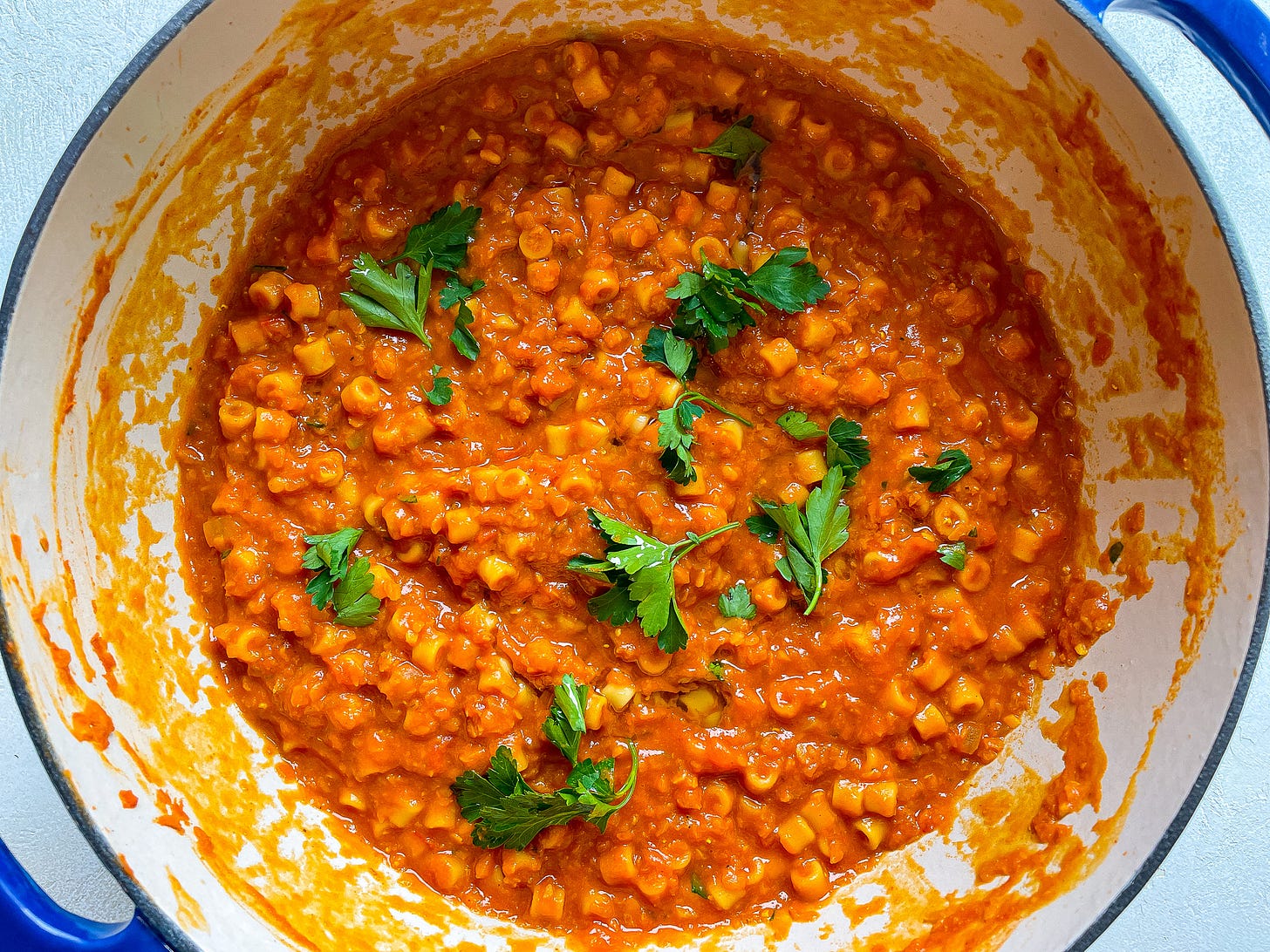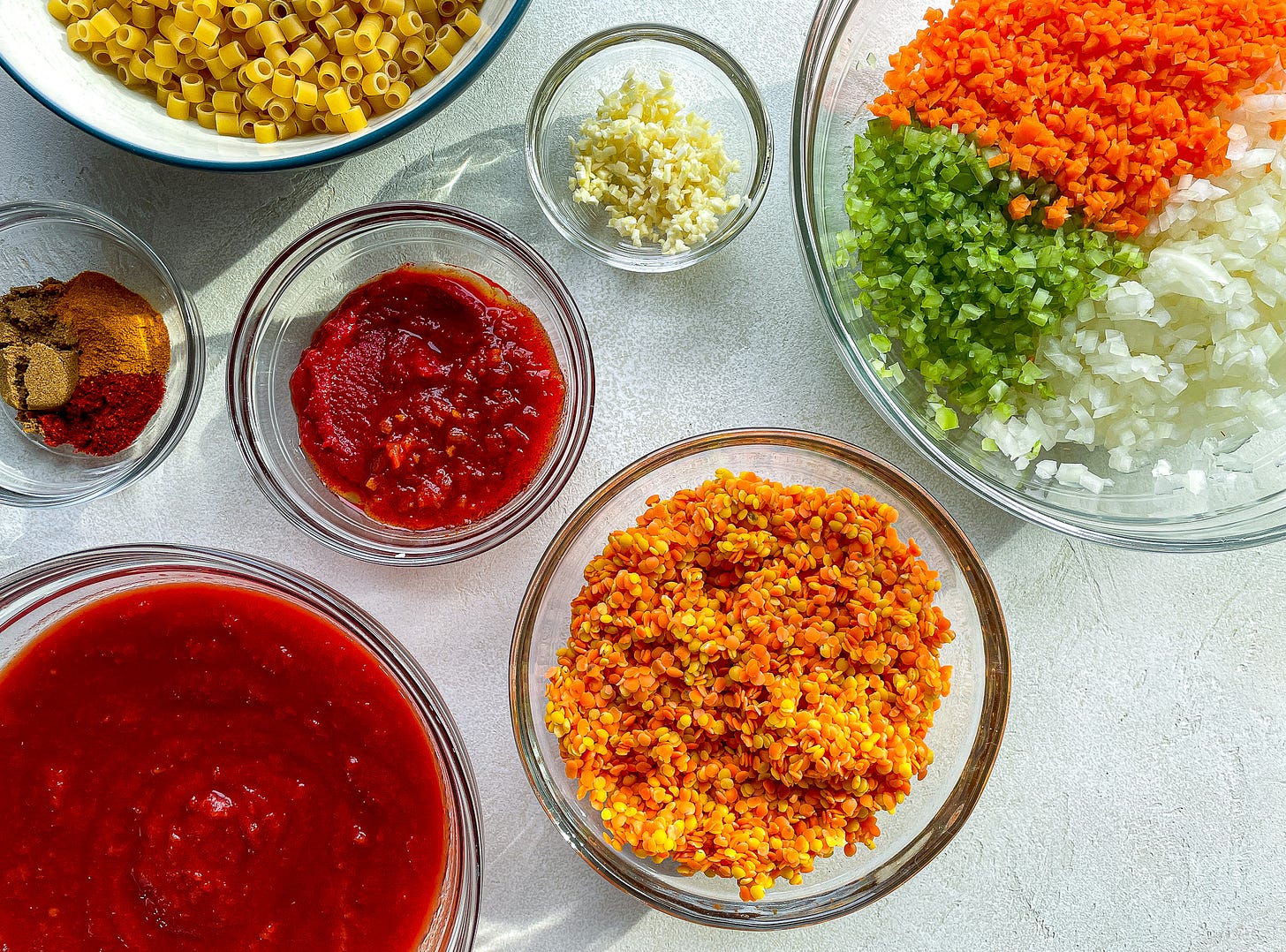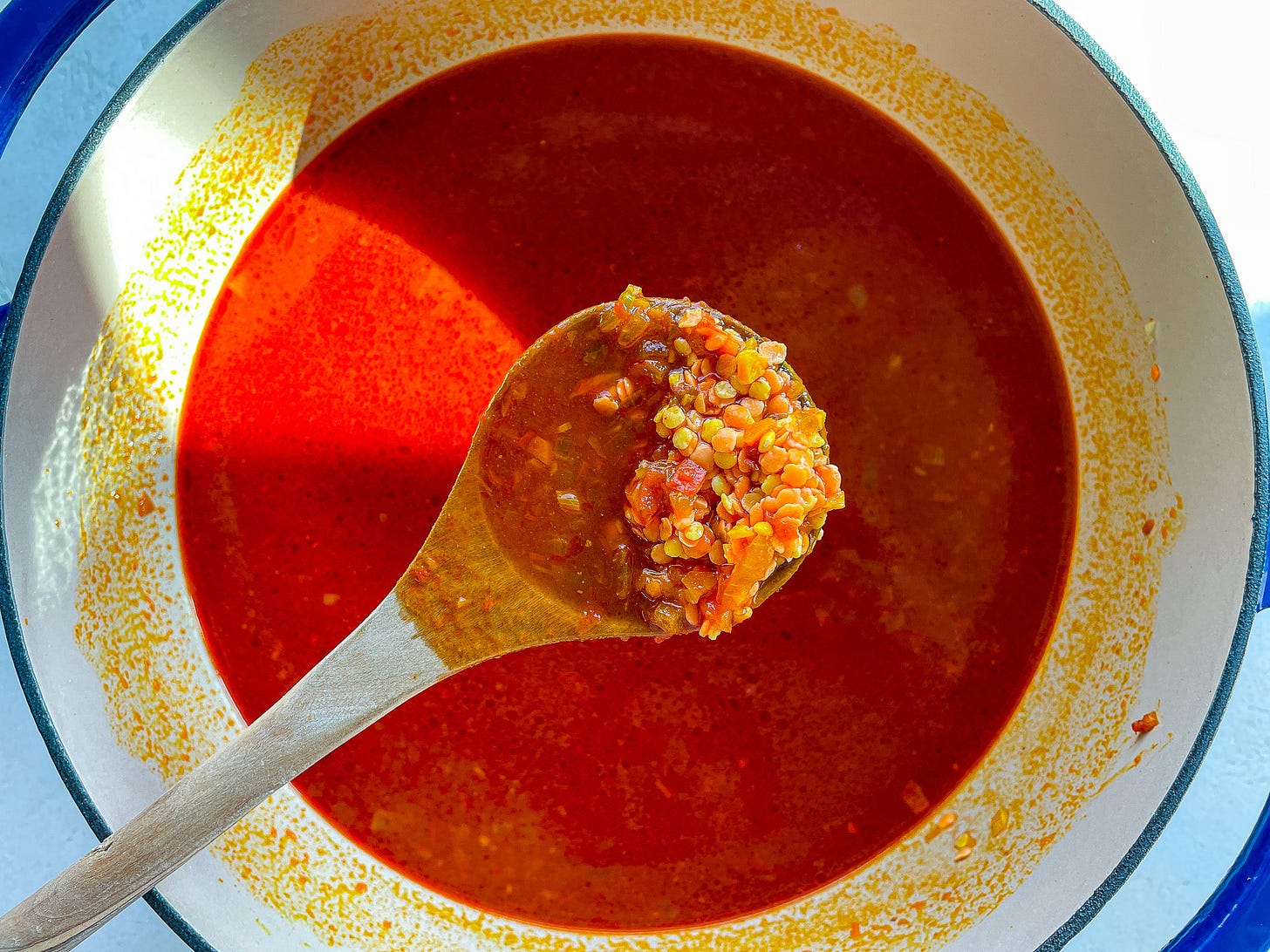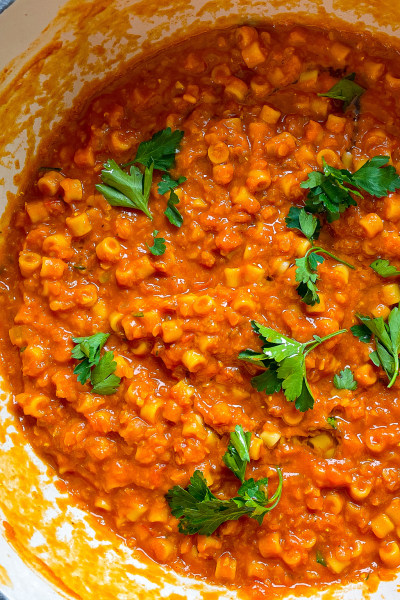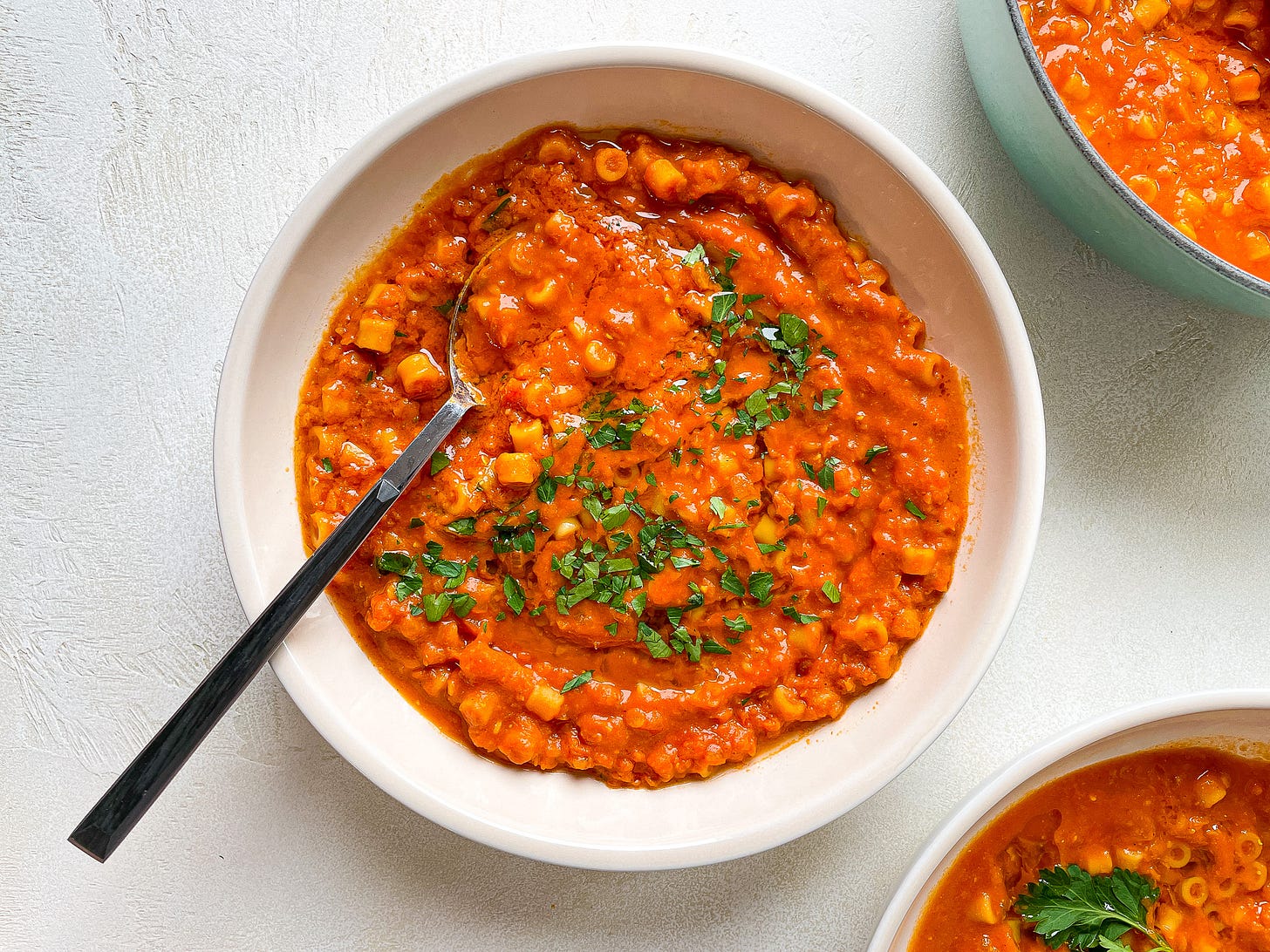In January, I swapped places with one of my favorite food writers, Giulia Scarpaleggia of
, and shared a riff on one of my treasured childhood recipes: spiced red lentil soup with ditalini. In turn, Giulia was kind enough to share her own pasta-soup recipe, packed with white beans, sage, and pasta mista—a nourishing and cheap meal that embodies the heart of Tuscan cooking (thank you, Giulia!).Somehow time has sped along and it’s already mid-March (!!), so I thought I’d re-share my lentil soup recipe here, both for those who might have missed it on Giulia’s page and because it’s an easy and delicious way to bid winter farewell. (Soup, I will miss you! Though it’s actually still pretty cold here in DC, so we might have more soup in us yet.) I think I’ll whip this up tonight!
PS: Giulia’s next cookbook, Cucina Povera, comes out April 4 and you won’t want to miss it. :-)
For five years, I ate red lentil soup once a week.
I grew up in a close-knit Jewish community on the outskirts of Washington, DC, and every Friday night—the start of Shabbat, the Jewish sabbath—we would gather with different groups of friends for dinner. Over time, the community adopted signature recipes. There was Kay’s challah, a chewy, slightly underbaked braided bread (often studded with cinnamon chips) that couldn’t be devoured fast enough. There was Rhonda’s seven-layer chocolate cake that I was lucky enough to get my hands on just a few months ago. On special occasions, there was my mom’s sweet, buttery noodle kugel, passed down from my grandma’s grandma and the best kind of heart attack on plate. And then there was the spicy red lentil soup.
Heirloom recipes aside, few things impacted my community’s culinary repertoire more than Susie Fishbein and Sandra Blank’s 2002 cookbook The Kosher Palette. Even now I can so clearly picture the cover—literally an artist’s palette and paintbrush fashioned from dark and white chocolate, with frozen globes of sorbet as its “paints.” Looking back, I owe a great deal to this book. It ushered in a new wave of Jewish cooking, with emphasis on bright flavors and exciting textures, a big step away from the typical meat-and-potato meals. The book inspired my mom and her friends to cook and eat new things. And so, as a standing guest of the Shabbat table, it inspired me to cook and eat new things, too.
Back to the soup. Every Shabbat dinner started with soup. Early on in what I’ll call The Kosher Palette Age (2002-2007), my mom discovered a recipe for a smooth and spicy red lentil soup, layered with aromatics that tingled on your tongue. The first time she made it, it was for immediate family only—a soup test drive. And it was wonderful: complex, warming, and wholly satisfying.
With the family’s stamp of approval, the soup began to appear on our table regularly, almost weekly. Then it appeared on our friends’ tables, and their friends’ tables, too. The soup became a reminder that, no matter where you were on Friday night, you felt at home. I imagine my teenage self got sick of the soup eventually, but now it only conjures fond memories of a simpler time.
My mom has, somehow, misplaced her copy of The Kosher Palette, so this recipe is an approximation based on her memory and my invention. The addition of ditalini (or any pasta) is my own, both because, after all, I write a newsletter called “pasta social club,” and because it makes for an even heartier, well-rounded meal.
Although this isn’t an Italian recipe, legume soups laden with pasta are a staple throughout the peninsula, particularly in the historically poor central and southern regions. Lentils are rich in protein, vitamins, minerals, and fiber, so they’re an excellent bang for your buck. They’re often eaten on holidays like New Year’s Eve as a symbol of prosperity, as well as during Lent as a meat substitute. Umbria boasts particularly delicious lentil varieties like lenticchie di Castelluccio di Norcia and lenticchie di Colfiorito. These lentils are small (similar to French Puy lentils) and cook quickly, with a nutty taste and creamy texture. The red lentils in this recipe also cook quickly, but their flavor and texture are entirely different—they’re milder, sweeter, and break down into a curry-like consistency instead of holding their shape. I like to blend half of the lentils for a creamier result (à la The Kosher Palette), but feel free to skip this step and keep things rustic.
I can’t think of a more perfect time than quiet, cold January March to resurrect this wholesome soup. I hope it soothes your soul like it does mine. And while it’s delicious any day of the week, I’d recommend giving it a try on Friday night.
Spiced Red Lentil Soup with Ditalini
Serves 4 to 6
¼ cup (60 ml) extra-virgin olive oil, plus more for serving
1 medium carrot, peeled and finely chopped
1 celery stalk, trimmed and finely chopped
1 small yellow onion, finely chopped
Kosher salt and freshly ground black pepper
4 garlic cloves, minced
1 teaspoon ground cumin
1 teaspoon smoked paprika
½ teaspoon ground turmeric
¼ teaspoon cayenne pepper (optional)
2 tablespoons (30 grams) tomato paste
2 tablespoons (30 grams) harissa (I used mild, so adjust to your liking)
1 cup (185 grams) red lentils, rinsed and picked through
1 14-ounce can (400 grams) crushed or diced tomatoes
4 cups (1 liter) low-sodium vegetable or chicken stock, plus more as needed
8 ounces (225 grams) ditalini or other small, soup-friendly pasta
Juice of ½ lemon
Chopped flat-leaf parsley, for serving
In a Dutch oven or large sauté pan, warm the oil over medium heat. Add the vegetables, season with salt and pepper, and cook, stirring occasionally, until soft but not browned, about 10 minutes. Stir in the garlic and spices and cook until sizzling and fragrant, 1 minute.
Add the tomato paste and harissa and cook, stirring often, until darkened in color, about 2 minutes. Stir in the lentils, tomatoes, stock, and a big pinch of salt. Swirl some water into the empty tomato tin to catch the residual juices and add that to the pot, too.
Bring to a boil, then reduce to a low simmer. Partially cover the pot and cook until the lentils are nearly tender, about 10 minutes. Season to taste with salt.
If you’d like, transfer a few ladles of the lentils to a blender and—being very careful with the hot liquid—process until smooth (alternatively, use an immersion blender to purée about half of the lentils). Return the blended lentils to the pot.
Return the pot to medium-high heat and add the pasta. Cook, stirring almost constantly, until the lentils are falling apart and the pasta is just shy of al dente, 10 to 15 minutes (the pasta will continue to soften in the heat of the soup). If the mixture looks very dry, add a splash more stock or water. Turn off the heat.
Stir in the lemon juice and adjust seasoning to taste. Divide the soup among bowls and serve, finished with a generous drizzle of good olive oil and a sprinkle of fresh parsley.
Note: This soup thickens very quickly into more of a stew/gravy. For a thinner consistency, add more stock or water and warm through.





